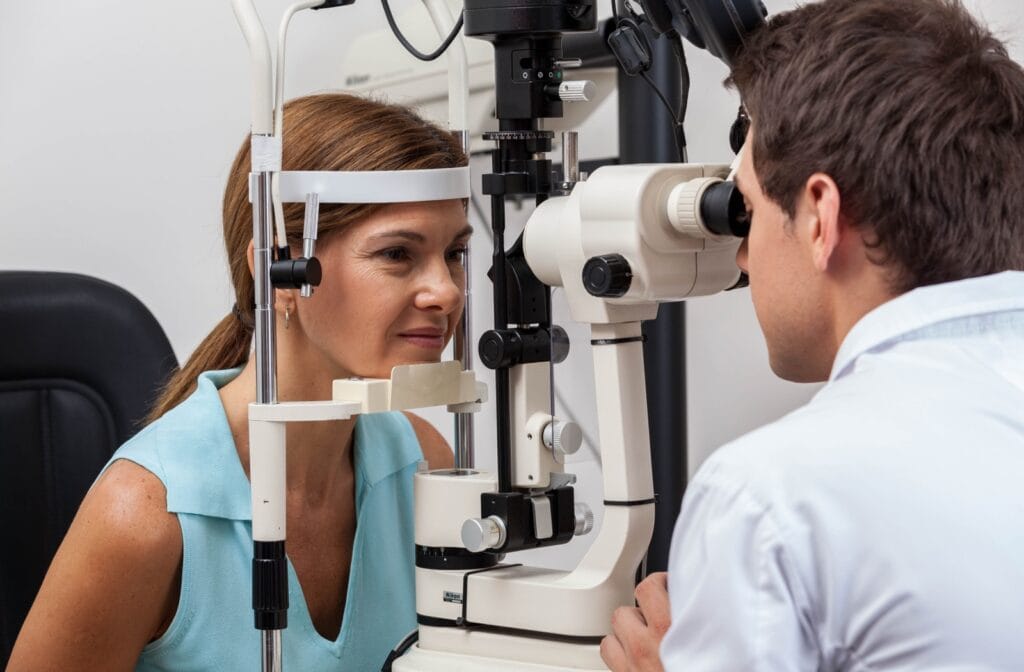When you hear terms like 20/20 or 20/40 vision during an eye exam, you may wonder what they mean for your sight. In simple terms, 20/40 vision means you can see at 20 feet what someone with “normal” vision can see from 40 feet.
While 20/40 vision isn’t a severe impairment, it does indicate that your vision is slightly less sharp than average. In this article, we’ll break down how 20/40 vision impacts your daily life and explore ways to improve your clarity.
Understanding How Vision is Measured
Optometrists use a test called the Snellen chart to measure vision. This is the chart you often see during eye exams. It features rows of letters that get increasingly smaller from top to bottom. To conduct the test, your optometrist will ask you to read the letters from a distance of 20 feet.
Your visual acuity is represented by two numbers. The first number (always 20) refers to the testing distance—how far you are from the chart. The second number indicates how far away a person with normal vision can stand and still read the same line.
For example:
- 20/20 vision: You can see at 20 feet what others with normal vision can also see at 20 feet.
- 20/40 vision: You need to be 20 feet away to see an object that others can see from 40 feet.
What Does 20/40 Vision Mean?
20/40 vision is generally considered mild visual impairment. While it’s not as clear as 20/20, it’s still within a range where most people can manage with minimal impact on their daily activities.
Key Points about 20/40 Vision:
- Legal driving standards: In many areas, you can legally drive with 20/40 vision, though restrictions may apply. Better vision, especially for spotting road signs or hazards from a distance, can improve safety behind the wheel.
- Daily activities: Tasks like reading small print or perceiving distant objects, such as road signs, may require more effort.
- Vision correction: Glasses or contact lenses can correct 20/40 vision.
Although some people adjust to 20/40 vision without issues, others find that it affects their ability to perform certain day-to-day tasks.
Causes of 20/40 Vision
Several factors can lead to 20/40 vision, ranging from common refractive errors to age-related conditions.
Refractive Errors
Refractive errors are the most frequent cause of vision impairment. These occur when the shape of your cornea or the lens of your eye affects how light strikes your retina. The common types of refractive errors include:
- Nearsightedness (Myopia): Difficulty seeing distant objects clearly.
- Farsightedness (Hyperopia): Difficulty seeing nearby objects clearly.
- Astigmatism: Irregular curvature of the eye, causing blurred vision at all distances.
Eye Conditions or Injuries
Conditions such as cataracts, glaucoma, or corneal scarring can also reduce visual clarity. Regular eye exams help detect these problems early on.
Digital Eye Strain
In today’s digital age, many people experience temporary blurry vision from extended screen time. This digital eye strain can mimic refractive errors, causing temporary discomfort and blurred vision that can make 20/40 vision feel worse.
How 20/40 Vision Affects Your Daily Life
The impact of 20/40 vision can vary depending on your lifestyle and the activities you engage in. Some people may hardly notice the difference, while others may find it a bit more challenging.
- Driving: With 20/40 vision, reading road signs or spotting distant objects while driving may become more difficult, especially in low-light conditions. Although many jurisdictions allow you to drive with 20/40 vision, improved vision means improved safety.
- Hobbies & Sports: Sports and activities that rely on sharp vision, like tennis, photography, or crafting, may become more challenging. The extra effort required for clear vision can take away some of the enjoyment from these activities.

Correcting 20/40 Vision
The good news is that 20/40 vision can be corrected. There are several options available.
Eyeglasses
Glasses are the most common and non-invasive solution. Glasses can improve clarity and provide a simple, effective way to address mild vision impairment. Plus, they come in a variety of styles to match your personal taste.
Contact Lenses
If you prefer not to wear glasses, contact lenses might be a good alternative. There are several types of contact lens, including daily, monthly, and disposable lenses, all of which offer convenience and comfort without sacrificing vision quality.
Refractive Surgery
For those seeking a permanent solution, laser surgery like LASIK or PRK may be an option. These procedures reshape the cornea to correct refractive errors, offering the potential for improved vision and even 20/20 clarity.
Managing Digital Eye Strain
If your 20/40 vision is exacerbated by digital eye strain, simple lifestyle adjustments can help. Try taking regular breaks from screens, ensuring proper lighting when reading, and maintaining a good posture while working. Nutritional support, such as omega-3 fatty acids and vitamins C and E, can also support eye health.
Get Help from Your Optometrist
If you have concerns about your 20/40 vision or simply want to ensure your eye health is on track, a visit to your optometrist is the best first step. At ERC Optometry, we offer personalized care to help you see the world clearly again. Our team can guide you toward the right corrective measures, from glasses to contact lenses, and ensure your eyes are in the best possible health.
Book your appointment today and start experiencing sharper, clearer vision with the help of our experienced optometrists!

